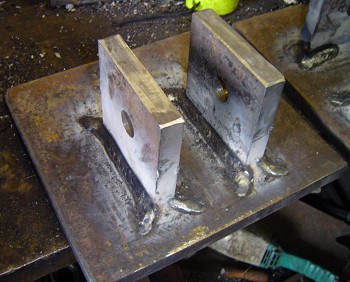Welding Engineering Steels
EN19 and EN24 / EN24T
EN19 and EN24 / EN24T are classed as Engineering Steels and are normally used because of their extremely high strength. They are used a lot in Fork Trucks (Tangs and Masts) and many other component parts.
In many cases the designer will specify their use without any thought for welding, and they are very difficult to weld.
It is possible to weld Engineering Steels successfully using mild steel fillers (7018s and SG2) but this method has a greater chance of hydrogen induced cracking and will also result in a weld much weaker than the parent.
The belt and braces approach is to preheat the parent to 250°C and weld 2 layers of E312 (electrode or wire) onto both of the surfaces to be welded. Allow to cool slowly, packed in sand or some other insulator. Once cool the surfaces can be welded together using the same 312 . If the joint is over 12mm thick it is important to stop welding after every layer and allow the weld to cool to room temperature. This is to prevent the weld becoming too hot and forming a very brittle microstructure known as Sigma.
The reason behind the use of E312 is that it is an austenitic / ferritic stainless steel with a tensile strength of over 800N/mm2 which is close to the parent which could be over 1000N/mm2. E312, being austenitic will absorb Hydrogen and therefore not allow it to pass into the Hydrogen crack susceptible structure of these steels.
- Preheat to 250°C
- Butter the faces with 2 layers of E312
- Allow to cool slowly
- Weld the buttered faces together using E312
- If over 12mm thick keep stopping and allow to cool
EN8
En8 is another engineering steel but not as problematic as En 24T etc. It used to be called 40 carbon steel meaning it had a high carbon content to impart high strength. These days it retains the strength levels (because of thermo mechanical rolling) yet it is much lower carbon so much easier to weld.
In fact if you use standard MIG wire (SG2) or a 7018 electrode you can weld it without preheat upto 18mm thick, over that a preheat of 100°C should prevent cracking.
All this assumes it is of western European origin. Some of the steel coming in from eastern Europe and the far east is loaded with carbon and may need up to 250°C preheat to prevent cracking.




